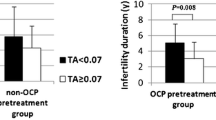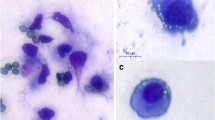Abstract
Objective
To study the effect of telomerase activity (TA) in human luteinised granulosa cells (GCs) on the outcome of in vitro fertilisation treatment.
Methods
Fifty-six women, aged 23 to 39 years, were enrolled and divided into four groups according to their levels of TA.
Results
Seventeen cases in group A exhibited nondetectable TA, 16 cases in group B expressed low levels of TA (between 0.1 and 0.65 OD × mm), 14 cases in group C expressed moderate TA levels (between 0.66 and 1.00 OD × mm) and 9 cases in group D expressed high levels of TA (more than 1.00 OD × mm). The level of total serum testosterone (T) was significantly higher in groups C and D than in group A (1.43 ± 0.10 vs. 1.08 ± 0.11 nmol/L, P < 0.030 and 1.56 ± 0.08 vs. 1.08 ± 0.11 nmol/L, P < 0.005, respectively). The TA level was positively correlated with T (r = 0.291, P < 0.011). No obvious differences were observed in rates of fertilisation, cleavage, mature oocyte formation or good-quality embryos among the groups. The patients in group D exhibited the highest rates of embryo implantation and clinical pregnancy (with rates of 52.63% and 77.78%, respectively, compared with 18.92% and 29.41% in group A, 25.71% and 37.50% in group B and 48% and 50% in group C, with P < 0.018 and P = 0.112, respectively). The patients in group D also had a greater likelihood of becoming pregnant than those in group A (OR: 9.703, P < 0.023), group B (OR: 14.765, P < 0.009) or group C (OR: 5.560, P = 0.103).
Conclusions
Luteinised GCs have a certain potential for proliferation and TA of luteinised GCs may predict the clinical outcomes of IVF treatment. Some unknown regulatory mechanisms between TA and T should be studied in further trials.


Similar content being viewed by others
References
Greider CW, Blackburn EH. A telomeric sequence in the RNA of Tetrahymena telomerase required for telomere repeat synthesis. Nature. 1989;337:331–7.
Lingner J, Cech TR. Purification of telomerase from Euplotes aediculatus: requirement of a primer 3′ overhang. Proc Natl Acad Sci USA. 1996;93:10712–7.
Lendvay TS, Morris DK, Sah J, Balasubramanian B, Lundblad V. Senescence mutants of Saccharomyces cerevisiae with a defect in telomere replication identify three additional EST genes. Genetics. 1996;144:1399–412.
Feng J, Funk WD, Wang SS, et al. The RNA component of human telomerase. Science. 1995;269:1236–41.
Blackburn EH. Telomere states and cell fates. Nature. 2000;408:53–6.
Hayflick L. The limited in vitro lifetime of human diploid cell strains. Exp Cell Res. 1965;37:614–36.
Broccoli D, Young JW, de Lange T. Telomerase activity in normal and malignant hematopoietic cells. Proc Natl Acad Sci. 1995;92:9082–6.
Harle-Bachor C, Boukamp P. Telomerase activity in the regenerative basal layer of the epidermis inhuman skin and in immortal and carcinoma-derived skin keratinocytes. Proc Natl Acad Sci. 1996;93:6476–81.
Kim NW, PiatyszekMA PKR, Harley CB, WestMD Ho PL, Coviello GM, Wright WE, et al. Specific association of human telomerase activity with immortal cells and cancer. Science. 1994;266:2011–5.
Shay JW, Bacchetti S. A survey of telomerase activity in human cancer. Eur J Cancer. 1997;33:787–91.
Kim NW, Piatyszek MA, Prowse KR, et al. Specific association of human telomerase activity with immortal cells and cancer. Science. 1994;266:2011–5.
Lavranos TC, Mathis JM, Latham SE, Kalionis B, Shay JW, Rodgers RJ. Evidence for ovarian granulosa stem cells: telomerase activity and localisation of the telomerase RNA component in bovine ovarian follicles. Biol Reprod. 1999;61:358–66.
Orly J. Molecular events defining follicular developments and steroidogenesis in the ovary. In: Shupnik MA, editor. Gene engineering in endocrinology. Totowa: Humana Press Inc; 2001. p. 239–76.
Gougeon A. Regulation of ovarian follicular development in primates: facts and hypotheses. Endocr Rev. 1996;17:121–55.
Russo V, Berardinelli P, Capacchietti G, et al. Localization of the telomerase catalytic subunit (TERT) in pig ovarian follicles. Vet Res Commun. 2003;27 Suppl 1:623–6.
Yoshiaki Y, Yasuhiko N, Kenji U, et al. Changes in telomerase activity in experimentally induced atretic follicles of immature rats. Endocrinology. 2002;49:589–95.
Liu W, Zhu GJ. Expression of telomerase in human ovarian luteinized granulosa cells and its relationship to ovarian function. Zhonghua Fu Chan Ke Za Zhi. 2003;38:402–4.
Van de Velde H, Nagy ZP, Joris H, De Vos A, Van Steirteghem AC. Effects of different hyaluronidase concentrations and mechanical procedures for cumulus cell removal on the outcome of intracytoplasmic sperm injection. Hum Reprod. 1997;12:2246–50.
Wen JM, Sun LB, Zhang M, Zheng MH. A non-isotopic method for the detection of telomerase activity in tumour tissues: TRAP-silver staining assay. Mol Pathol. 1998;51(2):110–2.
Greider CW. Telomere length regulation. Annu Rev Biochem. 1996;65:337–65.
Greenwood MJ, Lansdorp PM. Telomeres, telomerase, and hematopoietic stem cell biology. Arch Med Res. 2003;34:489–95.
Wright WE, Piatyszek MA, Rainey WE, Byrd W, Shay JW. Telomerase activity in human germline and embryonic tissues and cells. Dev Genet. 1996;18:173–9.
Lavranos TC, Rodgers HF, Bertoncello I, Rodgers RJ. Anchorage-independent culture of bovine granulosa cells: the effects of basic fibroblast growth factor and dibutyryl cAMP on cell division and differentiation. Exp Cell Res. 1994;211:245–51.
Lavranos TC, O’Leary PC, Rodgers RJ. Effects of insulin-like growth factors and binding protein-1 on bovine granulosa cell division in anchorage-independent culture. J Reprod Fertil. 1996;106:221–8.
Rodgers HF, Lavranos TC, Vella CA, Rodgers RJ. Basal lamina and other extracellular matrix produced by bovine granulosa cells in anchorage-independent culture. Cell Tissue Res. 1995;282:463–71.
Rodgers RJ, Vella CA, Rodgers HF, Scott K, Lavranos TC. Production of extracellular matrix, fibronectin and steroidogenic enzymes, and growth of bovine granulosa cells in anchorage-independent culture. Reprod Fertil Dev. 1996;8:249–57.
Lavranos TC, Rodgers RJ. An assay of tritiated thymidine incorporation into DNA by cells cultured under anchorage-independent conditions. Anal Biochem. 1995;223:325–7.
Wells DN, Misica PM, Tervit HR. Production of cloned calves following nuclear transfer with cultured adult mural granulosa cells. Biol Reprod. 1999;60:996–1005.
Campbell KHS, McWhir J, Ritchie WA, Wilmut I. Sheep cloned by nuclear transfer from a cultured cell line. Nature. 1996;380:64–6.
Wakayama T, Perry ACF, Zuccotti M, Johnson KR, Yanagimachi R. Full-term development of mice from enucleated oocytes injected with cumulus cell nuclei. Nature. 1998;394:369–74.
Rodgers RJ, Irving-Rodgers HF, van Wezel IL, et al. Dynamics of the membrana granulosa during expansion of the ovarian follicular antrum. Mol Cell Endocrinol. 2001;171:41–8.
Bouchal J, Baumforth KR, Svachova M, Murray PG, von Angerer E, Kolar Z. Microarray analysis of bicalutamide action on telomerase activity, p53 pathway and viability of prostate carcinoma cell lines. J Pharm Pharmacol. 2005;57:83–92.
Bouchal J, Kolar Z, Mad’arova J, Hlobilkova A, von Angerer E. The effects of natural ligands of hormone receptors and their antagonists on telomerase activity in the androgen sensitive prostatic cancer cell line LNCaP. Biochem Pharmacol. 2002;63:1177–81.
Soda H, Raymond E, Sharma S, Lawrence R, Davidson K, Oka M, et al. Effects of androgens on telomerase activity in normal and malignant prostate cells in vitro. Prostate. 2000;43:161–8.
Ravindranath N, Ioffe S, Marshall G, Ramaswamy S, Plant T, Dym M. Androgen depletion activates telomerase in the prostate of nonhuman primate, Macaca mulatta. Prostate. 2001;49:79–89.
Meeker A, Sommerfeld H, Coffey D. Telomerase is activated in the prostate and seminal vesicles of the castrated rat. Endocrinology. 1996;137:5743–6.
Weil S et al. Androgen and follicle-stimulating hormone interactions in primate ovarian follicle development. J Clin Endocrinol Metab. 1999;84:2951–6.
Hickey TE et al. Androgens augment the mitogenic effects of oocyte-secreted factors and growth differentiation factor 9 on porcine granulosa cells. Biol Reprod. 2005;73:825–32.
Vendola K et al. Androgens promote insulin-like growth factor-I and insulin-like growth factor-I receptor gene expression in the primate ovary. Hum Reprod. 1999;14:2328–32.
Vendola K et al. Androgens promote oocyte insulin-like growth factor I expression and initiation of follicle development in the primate ovary. Biol Reprod. 1999;61:353–7.
Tetsuka M, Hillier SG. Differential regulation of aromatase and androgen receptor in granulosa cells. J SteroidBiochem Molec Biol. 1997;61:233–9.
Hillier SG, Tetsuka M. Role of androgens in follicle maturation and atresia. Baillieres Clin Obstet Gynaecol. 1997;11:249–60.
Jia XC, Ny T, Hsueh AJW. Synergistic effect of glucocorticoids and androgens on the hormonal induction of tissue plasminogen activator activity and messenger ribonucleic acid levels in granulosa cells. Molec Cell Endocrinol. 1990;68:143–51.
Hillier SG, Ross GT. Effects of exogenous testosterone on ovarian weight, follicular morphology and intraovarian progesterone concentration in estrogen-primed hypophysectomized immature female rats. Biol Reprod. 1979;20:261–8.
Nandedkar TD, Munshi SR. Effect of dihydrotestosterone on follicular development, ovulation and reproductive capacity of mice. J Reprod Fertil. 1981;62:21–4.
Murray AA et al. Effect of androgens on the development of mouse follicles growing in vitro. J Reprod Fertil. 1998;113:27–33.
Buccione R, Schoroeder AC, Eppig JJ. Interactions between somatic cells and germ cells throughout mammalian oogenesis. Biol Reprod. 1990;43:543–7.
Klinger FG, De Felici M. In vitro development of growing oocytes from fetal mouse oocytes: stage-specific regulation by stem cell factor and granulosa cells. Dev Biol. 2002;244:85–95.
Johnson JE, Lee Higdon III H, Boone WR. Effect of human granulosa cell co-culture using standard culture media on the maturation and fertilization potential of immature human oocytes. Fertil Steril. 2008;90:1674–9.
Boon CH, Tong GQ, Ng SC, et al. Effects of granulosa coculture on in-vitro oocyte meiotic maturation within a putatively less competent murine model. Theriogenology. 2004;62:1066–92.
Niu ZH, Yun F. The clinical study of relationship between serum E2/P ratio on the day of HCG injection and embryo implantation. J Pract Obstet gynecol. 2005;21:370–2.
Acknowledgments
We thank all of the patients and family members for their participation. This study was supported by the Science Research of Population and Family Planning Commission of Guangdong Province in China (Grant No. 2009231), the Science Technology Research and Development Project of Guangdong Province (Grant No. 2010B031600043) and the Science Technology Research Project of Guangdong Province(Grant No. 2008B080701026).
Author information
Authors and Affiliations
Corresponding author
Additional information
Capsule
Telomerase activity of ovarian luteinised GCs can help us predict the clinical outcomes of IVF treatment
Rights and permissions
About this article
Cite this article
Chen, H., Wang, W., Mo, Y. et al. Women with high telomerase activity in luteinised granulosa cells have a higher pregnancy rate during in vitro fertilisation treatment. J Assist Reprod Genet 28, 797–807 (2011). https://doi.org/10.1007/s10815-011-9600-2
Received:
Accepted:
Published:
Issue Date:
DOI: https://doi.org/10.1007/s10815-011-9600-2




